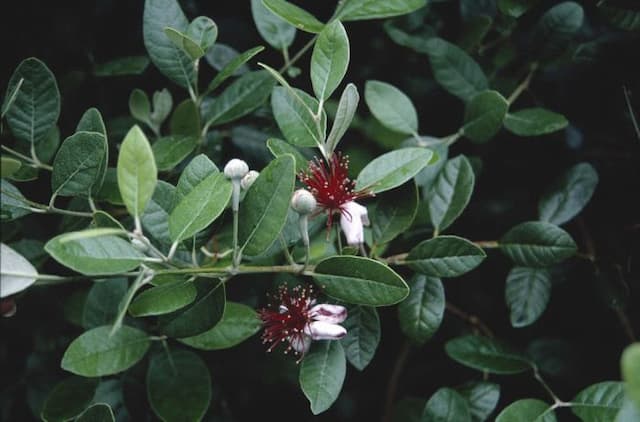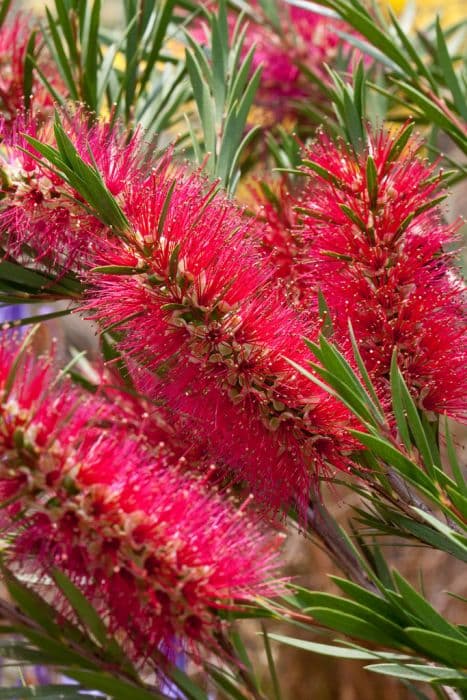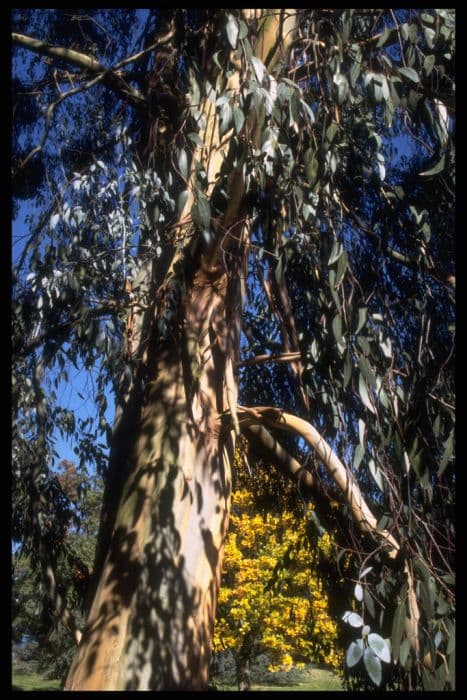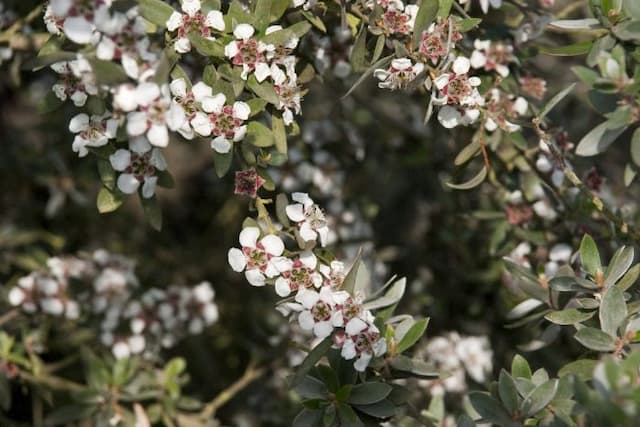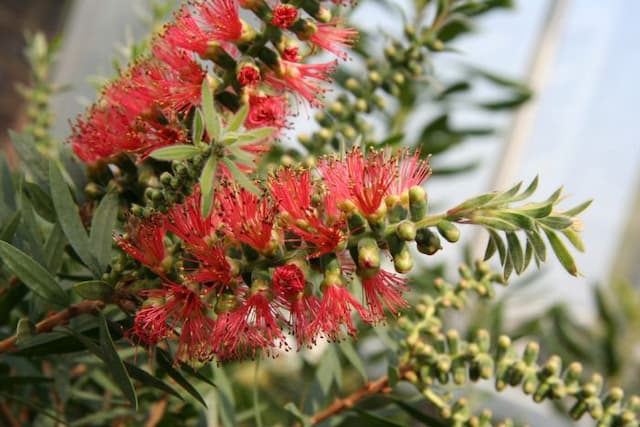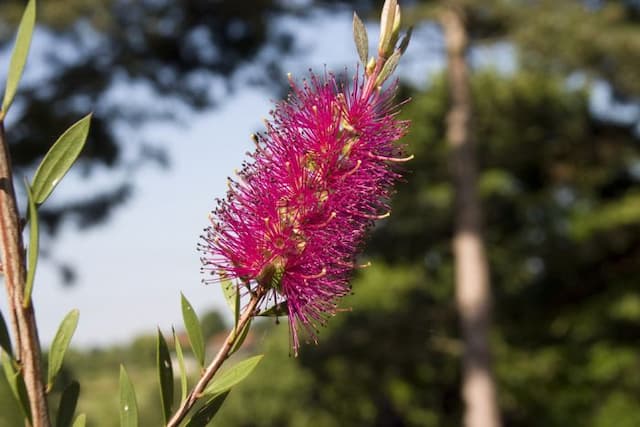Silver Mountain Gum Eucalyptus pulverulenta

ABOUT
Eucalyptus pulverulenta, commonly known as the silver-leaved mountain gum, is an eye-catching plant renowned for its distinct silver-blue leaves. The leaves are round, powdery, and have a shimmering silvery quality to them that makes the plant stand out, especially when young. Older leaves may become elongated. The plant's branches are densely covered in foliage creating a lush, full appearance. The silver-leaved mountain gum produces clusters of small white flowers that contrast beautifully with its striking foliage. These blossoms can attract a variety of pollinators to the garden. The bark of the plant is another notable feature; it can exhibit a patchy pattern as it peels away in flakes, revealing different shades underneath that add to the overall visual interest of the plant. This eucalyptus is often admired for its aromatic leaves that release a pleasant fragrance when crushed. The combination of its unique color, pleasing scent, and attractive flowers makes the silver-leaved mountain gum quite popular for use in flower arrangements and as an ornamental garden specimen.
About this plant
 Names
NamesFamily
Myrtaceae
Synonyms
Silver-leaved Mountain Gum, Silver-leaved Gum, Silver Gum, Powdered Gum
Common names
Eucalyptus pulverulenta
 Toxicity
ToxicityTo humans
Eucalyptus, specifically Eucalyptus pulverulenta, contains compounds that are toxic to humans if ingested. The leaves and oil are the most toxic parts. If someone consumes eucalyptus, they could experience symptoms such as stomach pain, nausea, vomiting, diarrhea, dizziness, feelings of suffocation, and weakness. In severe cases, ingesting eucalyptus can lead to central nervous system depression and can even be life-threatening.
To pets
Eucalyptus is also toxic to pets, including dogs and cats. If pets ingest eucalyptus, they may exhibit symptoms such as salivation, vomiting, diarrhea, depression, and weakness. In severe cases, ingestion can result in seizures and even lead to coma. Pet owners should ensure that their animals do not have access to any part of the eucalyptus plant.
 Characteristics
CharacteristicsLife cycle
Perennials
Foliage type
Evergreen
Color of leaves
Blue-green
Flower color
Creamy-white
Height
10 feet (3 meters)
Spread
6 feet (1.8 meters)
Plant type
Tree
Hardiness zones
8
Native area
Australia
Benefits
 General Benefits
General Benefits- Ornamental Value: The Eucalyptus pulverulenta, commonly known as the Silver-leaved Mountain Gum, is often appreciated for its striking bluish-gray, rounded leaves which are popular in floral arrangements and as garden ornamentals.
- Essential Oils: While excluding direct medical benefits, the plant is known for producing essential oils that are widely used in the fragrance and flavoring industries.
- Drought Resistance: This species is well-adapted to dry environments and is used in landscaping to reduce the need for water.
- Erosion Control: Its root system can help stabilize soil and prevent erosion, making it useful for ecological restoration and landscaping on slopes or in areas prone to soil degradation.
- Wildlife Habitat: Eucalyptus pulverulenta can provide habitat for various forms of wildlife, including birds that might nest in its branches and feed on its nectar or insects it attracts.
- Fodder: Although not the primary choice for forage, in certain regions, the leaves may serve as emergency fodder for livestock.
 Medical Properties
Medical Properties- Antibacterial: Eucalyptus pulverulenta contains eucalyptol, which has been found to possess antibacterial properties.
- Antiseptic: Traditionally used for its antiseptic qualities, the oil can be applied to minor wounds and cuts.
- Decongestant: Inhalation of the vapor has been used to alleviate nasal congestion.
- Anti-inflammatory: Some compounds in the eucalyptus oil derived from the leaves are known to have anti-inflammatory effects.
- Analgesic: The plant has been used in traditional medicine for its pain-relieving properties.
 Air-purifying Qualities
Air-purifying QualitiesThis plant is not specifically known for air purifying qualities.
 Other Uses
Other Uses- Floral Arrangements: Eucalyptus pulverulenta, commonly known as Silver-leaved Mountain Gum, is popular in the floral industry for its attractive foliage and is often used in bouquets and centerpieces for its unique silvery-blue leaves and rounded shape.
- Artistic Dye: The leaves of the Silver-leaved Mountain Gum can be used to produce a natural dye for fabrics, yielding a range of colors from yellows to greens depending on the mordant used.
- Essential Oil Production: While not a medical use, the oil extracted from the leaves of the Silver-leaved Mountain Gum is used in perfumery and aromatherapy for its strong, clean, and refreshing fragrance.
- Photography Props: The striking foliage of the Silver-leaved Mountain Gum is often used as a backdrop or prop in photographs to add texture and a touch of nature to the composition.
- Culinary Garnish: Though not commonly consumed, some chefs use sprigs of the Silver-leaved Mountain Gum to add an ornamental touch to dishes, much like a garnish.
- Handicraft Material: The leaves and wood of the Silver-leaved Mountain Gum are sometimes incorporated into handcrafted items like wreaths, potpourri, or decorative crafts for their aesthetic appeal.
- Religious Ceremonies: Certain cultures may use the branches and leaves of the Silver-leaved Mountain Gum during spiritual or religious ceremonies for their symbolic meanings or as part of ritual offerings.
- Insect Repellent: The natural compounds found in the Silver-leaved Mountain Gum, particularly in the leaves, can be used as a botanical insect repellent to ward off pests.
- Odor Neutralizer: Fresh leaves of the Silver-leaved Mountain Gum can be used in closets, drawers, or rooms to provide a natural way to neutralize odors and impart a fresh scent.
- Seed Pods for Crafts: The seed pods of the Silver-leaved Mountain Gum have a unique appearance and can be used in crafting and as decorative elements in potpourri mixes.
Interesting Facts
 Feng Shui
Feng ShuiThe Silver-leaf Mountain Gum is not used in Feng Shui practice.
 Zodiac Sign Compitability
Zodiac Sign CompitabilityThe Silver-leaf Mountain Gum is not used in astrology practice.
 Plant Symbolism
Plant Symbolism- Healing: Eucalyptus is often associated with healing because its leaves contain properties that can relieve respiratory issues and soothe physical ailments.
- Protection: The plant is believed to ward off evil spirits and protect individuals from harm, making it a symbol of safeguarding.
- Refreshment: The crisp, clean fragrance of eucalyptus is symbolic of cleansing and rejuvenating both the mind and environment.
- Purification: Eucalyptus is considered a purifying plant, representing the cleansing of negativity and the promotion of positive energy.
 Water
WaterThe Silver-leaved mountain gum, Eucalyptus pulverulenta, prefers consistent moisture but requires well-draining soil to prevent root rot. Water the plant deeply once a week, providing around 1 to 2 gallons per session for an established tree—it's important to ensure the water penetrates the root zone effectively. During hot and dry periods, the frequency may need to increase to twice a week. Always check the soil moisture level before watering; the top inch should be dry to the touch. Reduce watering in the winter when the plant's growth slows down.
 Light
LightSilver-leaved mountain gum thrives in full sunlight. It's best positioned in a location where it can receive at least six to eight hours of direct, unfiltered sunlight daily. Avoid shady areas as insufficient light can lead to poor growth and a reduction in the aromatic oils for which eucalyptus is renowned.
 Temperature
TemperatureSilver-leaved mountain gum is hardy and can tolerate temperatures as low as 20 to 50 degrees Fahrenheit, but it prefers a range between 60 to 80 degrees Fahrenheit for ideal growth. Protect it from extreme cold, as temperatures below 20 degrees Fahrenheit can damage or kill the plant.
 Pruning
PruningPruning the Silver-leaved mountain gum is necessary to maintain its desired shape and promote healthy growth. The best time for pruning is late winter or early spring before new growth begins. Prune as needed to remove dead or damaged branches, thin out dense growth, and shape the plant. It's typically done once a year but monitor the tree's growth and prune as necessary.
 Cleaning
CleaningNot needed
 Soil
SoilSilver-leaved mountain gum prefers well-draining soil with a potting mix that includes sand or perlite. Soil pH should be slightly acidic to neutral, ranging from 6.0 to 7.5 for optimal growth.
 Repotting
RepottingSilver-leaved mountain gum should be repotted every 1-2 years, especially when young and growing quickly, to ensure enough space for root development and to refresh the soil nutrients.
 Humidity & Misting
Humidity & MistingSilver-leaved mountain gum thrives in moderate to low humidity environments, as it is tolerant of dry air conditions typical of its native Australian habitat.
 Suitable locations
Suitable locationsIndoor
Ensure full sun, well-draining soil, and good air circulation.
Outdoor
Plant in full sun, provide space for growth, and protect from cold winds.
Hardiness zone
8-11 USDA
 Life cycle
Life cycleEucalyptus pulverulenta, commonly known as the Silver-leaved Mountain Gum, begins life as a seed which germinates in well-drained soil with plenty of sunlight. The seedling then grows rapidly, developing a straight stem and a branching habit, forming a juvenile foliage stage characterized by opposite, round, and blue-green leaves. As the tree matures, it undergoes a transition to adult foliage which is typically lance-shaped, pendulous, and a bluish-gray color; this stage is achieved when the plant is several years old. During its reproductive stage, Eucalyptus pulverulenta produces clusters of small white flowers that are attractive to bees and other pollinators. Following pollination, woody capsules form which contain numerous seeds, these capsules will eventually open to disperse the seeds, completing the reproductive cycle. Under suitable conditions, the tree can live for several decades, during which it may undergo periods of dormancy or regrowth in response to environmental factors such as fire or drought.
 Propogation
PropogationPropogation time
Spring-summer
The most popular method for propagating Eucalyptus pulverulenta, commonly known as the Silver-Leaved Mountain Gum, is through seed germination. This is typically done in the spring or summer when the temperatures are warm enough to facilitate germination. To propagate by seed, one would first collect the seeds from the capsule fruit of the plant once they have matured. These seeds are then sown on the surface of a well-draining seed raising mix and lightly covered with a fine layer of soil. The surface should be kept moist but not overly wet, and the seeds require a bright but not directly sunny location. Germination usually occurs within two to four weeks, and once the seedlings have grown large enough to be handled, they can be transplanted into individual pots.


